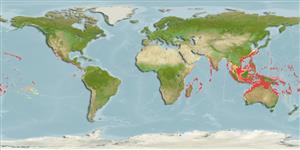>
Eupercaria/misc (Various families in series Eupercaria) >
Labridae (Wrasses) > Bodianinae
Etymology: Bodianus: Bodianus after Bodiano or Pudiano, from the Portuguese pudor, meaning modesty (Jordan & Evermann, 1896); bilunulatus: Name formed from the Latin adverb bis, for twice and Latin diminutive noun lunula (luna + ulus) for 'somewhat like the moon'; apparently referring to the lunate caudal fin (double emarginate with filamentous lobes) of the type specimen (Ref. 75973).
More on author: Lacepède.
Environment: milieu / climate zone / Tiefenbereich / distribution range
Ökologie
seewasser riff-verbunden; tiefenbereich 3 - 160 m (Ref. 9823). Tropical; 30°N - 30°S, 30°E - 134°W
Indo-West Pacific: east coast of Africa to Japan, the Philippines and New Caledonia.
Size / Gewicht / Alter
Geschlechtsreife: Lm ? range ? - ? cm
Max length : 55.0 cm TL Männchen/unbestimmt; (Ref. 4392); max. veröff. Gewicht: 1.8 kg (Ref. 4887)
Rückenflossenstacheln (insgesamt) : 12; Rückenflossenweichstrahlen (insgesamt) : 10; Afterflossenstacheln: 3; Afterflossenweichstrahlen: 12. Young easily identified by the unusual coloration. Adults normally have an oval shaped black saddle near the tail, but it may become indistinct in large males (Ref. 48636).
Body shape (shape guide): fusiform / normal.
Adults occur on deep reef slopes rich with invertebrates such as sponges and seawhips, but young adults are occasionally seen much shallower (Ref. 48636). Usually solitary in coral and rocky reefs. Feed mainly on benthic, hard-shelled, invertebrates such as mollusks and crustaceans. Protogynous (Ref. 55080). Oviparous, distinct pairing during breeding (Ref. 205).
Life cycle and mating behavior
Geschlechtsreife | Fortpflanzung | Ablaichen | Eier | Fecundity | Larven
Oviparous, distinct pairing during breeding (Ref. 205). Size at sex change: 38.6-40.5 cm L (Ref. 55080).
Westneat, M.W., 2001. Labridae. Wrasses, hogfishes, razorfishes, corises, tuskfishes. p. 3381-3467. In K.E. Carpenter and V. Niem (eds.) FAO species identification guide for fishery purposes. The living marine resources of the Western Central Pacific. Vol. 6. Bony fishes part 4 (Labridae to Latimeriidae), estuarine crocodiles. FAO, Rome. (Ref. 9823)
IUCN Rote Liste Status (Ref. 130435: Version 2024-2)
Nutzung durch Menschen
Fischereien: weniger kommerziell; Sportfisch: ja; Aquarium: Kommerziell
Tools
Zusatzinformationen
Download XML
Internet Quellen
Estimates based on models
Preferred temperature (Ref.
123201): 23.6 - 28.8, mean 27.4 °C (based on 932 cells).
Phylogenetic diversity index (Ref.
82804): PD
50 = 0.5000 [Uniqueness, from 0.5 = low to 2.0 = high].
Bayesian length-weight: a=0.01230 (0.00569 - 0.02662), b=3.05 (2.87 - 3.23), in cm total length, based on LWR estimates for this Genus-body shape (Ref.
93245).
Trophic level (Ref.
69278): 3.4 ±0.49 se; based on food items.
Widerstandsfähigkeit (Ref.
120179): niedrig, Verdopplung der Population dauert 4,5 - 14 Jahre. (Preliminary K or Fecundity.).
Fishing Vulnerability (Ref.
59153): Moderate vulnerability (42 of 100).
🛈
Nutrients (Ref.
124155): Calcium = 33.5 [19.8, 51.9] mg/100g; Iron = 0.511 [0.303, 0.904] mg/100g; Protein = 18.5 [15.6, 20.7] %; Omega3 = 0.143 [0.098, 0.211] g/100g; Selenium = 44 [27, 72] μg/100g; VitaminA = 82.7 [26.3, 281.8] μg/100g; Zinc = 1.19 [0.88, 1.84] mg/100g (wet weight);
